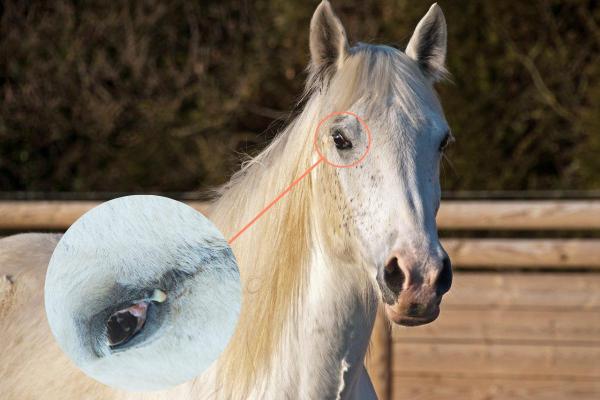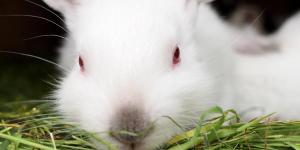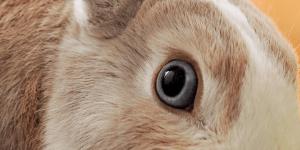Conjunctivitis in Horses



See files for Horses
Has your horse been squinting, weeping, or sporting a red, irritated eye? You might be facing a common foe: conjunctivitis, also known as pink eye. While it might seem like a minor inconvenience, understanding and recognizing this condition is crucial for your horse's well-being. Untreated, it can lead to further discomfort for your horse, potential complications like corneal ulcers, and even vision loss in severe cases.
This AnimalWised article explores conjunctivitis in horses, also known as pink eye. We'll explore its causes, symptoms, and treatment options, so you can be prepared to help your furry friend.
What is conjunctivitis in horses?
Equine conjunctivitis refers to the inflammation of the conjunctiva, the pink mucous membranes surrounding the eye. This inflammation may arise from an infection or other non-infectious factors. Although more prevalent in young horses, conjunctivitis can affect horses of any age.
It is crucial to emphasize that any deviation from normalcy in a horse's eye should be treated as a medical emergency. Immediate veterinary attention is warranted, as eye issues in horses can escalate rapidly and potentially lead to serious complications.
Causes of conjunctivitis in horses
Conjunctivitis in horses can be categorized into primary and secondary forms, each with various underlying causes.
Primary causes
These directly affect the conjunctiva itself:
- Irritants: particles like dust, hay, shavings, or pollen can get lodged in the eye, causing irritation and inflammation.
- Trauma: horses have large, sensitive eyes, making them prone to injuries that can lead to conjunctivitis.
- Infections: bacteria, viruses, fungi, and parasites can all invade the eye, causing inflammation and discharge.
Flies can also transmit infectious agents. - Tumors: though less common, various types of tumors can develop in or around the eye, causing conjunctivitis as a symptom.
- Allergies: just like humans, horses can have allergies to dust, pollen, or other environmental factors, leading to irritated and inflamed eyes.
Secondary causes
These arise from underlying problems in other parts of the eye or body:
- Other eye diseases: issues with the eyelids, cornea, iris, or tear ducts can cause secondary conjunctivitis. Examples include keratitis (corneal inflammation), corneal abscesses, and uveitis.
- Systemic diseases: in foals, conjunctivitis might indicate conditions like placentitis, neonatal foal maladjustment syndrome, or infections. In adults, it could be linked to neurological disorders, protozoal diseases, or viral infections like African horse sickness.
Symptoms of conjunctivitis in horses
The clinical signs most commonly observed in horses with conjunctivitis include:
- Redness: the pink lining of the eyelids, called the conjunctiva, becomes inflamed and red, giving it a "pink eye" appearance.
- Puffy eyes: the conjunctiva swells up, making the eye appear puffy and thickened.
- Teary eyes: excessive tears stream down the face, due to the irritated eye producing more than usual.
- Eye discharge: discharge from the eye can vary, ranging from a clear, watery fluid (viral/allergic) to a thick, pus-like discharge (bacterial).
- Lumpy bumps: in some cases, small, round bumps called lymphoid follicles might develop around the eye due to inflammation.
- Nodular lesions: occasionally, specific parasitic infections like Habronema or Onchocerca can cause nodular, inflammatory lesions around the eye.
You might be interested in the captivating story of how horses came to be in our other article on the origin and evolution of horses.
Diagnosis of conjunctivitis in horses
To accurately diagnose conjunctivitis in horses and differentiate between primary and secondary cases, a thorough investigation is necessary. Here are the key points:
- General examination: a comprehensive examination of the horse is essential to identify signs that may indicate the presence of a systemic disease.
- Ophthalmological examination: a complete examination of the eyes is crucial to detect any ocular alterations that could be contributing to the inflammation of the conjunctiva.
- Distinguishing primary from secondary conjunctivitis: when no other signs of associated ocular or systemic disease are found, it can be considered primary conjunctivitis.
For primary conjunctivitis, further investigation and complementary tests may include:
- Microbiological culture: this helps identify the presence of bacteria, viruses, and/or fungi. Interpretation of microbial culture and conjunctival cytology is crucial for an accurate diagnosis.
- Antibiogram: conducting an antibiogram is important to determine the sensitivity of the infectious agent to different antibiotic groups. This aids in establishing specific antibiotic therapy and helps prevent antibiotic resistance.
- Cytology: conjunctival scrapings can be examined cytologically to provide additional insights into the nature of the inflammation.
- Histopathological diagnosis: in some cases, a conjunctival biopsy may be performed for a histopathological examination.
Expand your horse care knowledge by exploring various parasites in our other article.
Treatment of conjunctivitis in horses
As previously noted, it is crucial to distinguish between primary and secondary conjunctivitis for both diagnosis and treatment.
Primary conjunctivitis
- Sand in the eye: Your veterinarian will gently remove the offending particle and flush the eye with a soothing solution.
- Bacterial or fungal infection: targeted antibiotics or antifungal medications will be prescribed based on the identified culprit. Remember, initial broad-spectrum treatment might be followed by more specific medication based on lab results.
- Parasitic infection: specific antiparasitic medication will be given to combat the worm or bug causing the problem. If lesions form, gentle removal and corticosteroid treatment might be needed.
- Tumor troubles: depending on the type and severity, surgical removal, cryotherapy, radiation, or chemotherapy might be used.
- Allergic reaction: corticosteroid eye drops can help soothe the irritation, but the key is avoiding the allergen, whether it's dust, pollen, or another trigger.
Secondary conjunctivitis
- Unmask the source: this requires a thorough examination to identify the underlying issue like eyelid problems, corneal ulcers, or even systemic diseases. Eye tests and analysis of secretions might be needed to determine the treatment.
Every horse and case is unique. Consulting your veterinarian is crucial for accurately identifying the cause of your horse's conjunctivitis and tailoring the best treatment plan for a speedy and complete recovery.
Prognosis of conjunctivitis in horses
Conjunctivitis in horses can have varying outcomes depending on the root cause. Here's a breakdown of potential scenarios and their prognoses:
- Infectious conjunctivitis: typically responds well to antibiotic treatment within 5-7 days. Lack of improvement or recurrence suggests a hidden culprit, like a foreign body in the eye. Seek immediate veterinary attention.
- Conjunctival tumors: prognosis depends heavily on the specific tumor type and its extent. Early diagnosis and treatment are crucial. Consult a veterinarian specializing in ophthalmology for optimal management.
- Allergic conjunctivitis: complete elimination can be difficult if the trigger (dust, pollen) can't be avoided entirely. Antihistamines and minimizing allergen exposure can improve comfort and prevent flare-ups.
- Secondary conjunctivitis: prognosis depends heavily on the underlying systemic disease. Some conditions have better outcomes than others. Early diagnosis and treatment of the primary disease are crucial for improving eye health and overall well-being.
Prompt veterinary intervention leads to better outcomes in all cases. Don't self-treat, as it could worsen the condition. For complex cases, consult an ophthalmologist for specialized treatment options.
This article is purely informative. AnimalWised does not have the authority to prescribe any veterinary treatment or create a diagnosis. We invite you to take your pet to the veterinarian if they are suffering from any condition or pain.
If you want to read similar articles to Conjunctivitis in Horses, we recommend you visit our Eye problems category.
- Bauer, B. (2015). Ocular pathology. Vet Clin Equine; 31:425-448
- Brooks, D. E. (2010). Equine conjunctival diseases: A commentary. Equine Veterinary Education; 882-386
- Carastro, S. (2004). Equine ocular anatomy and ophtalmic examination . Vet clin equine; 20: 285-299.





